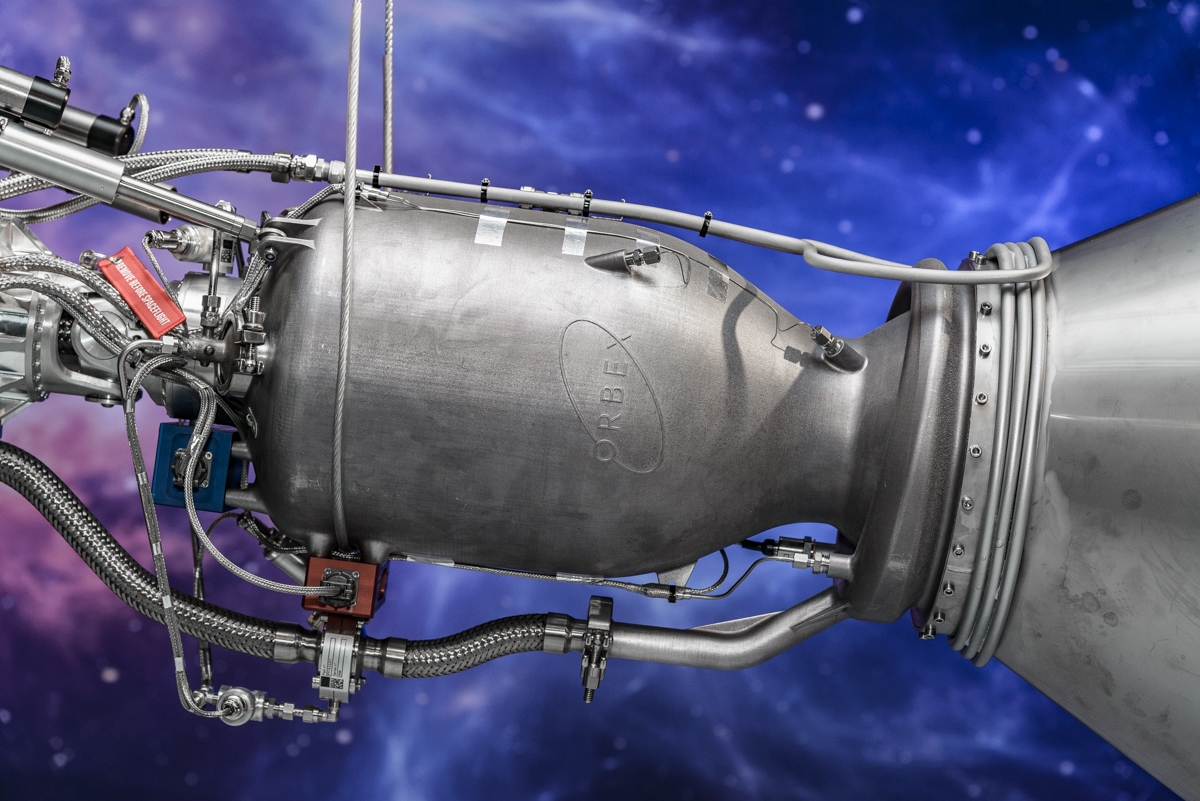British Rocketmaker Orbex Unveils Prototype of Small-Satellite Launcher

FORRES, SCOTLAND — Orbex, a United Kingdom-based rocket startup, just unveiled part of its new Prime small-satellite launcher, which the company hopes will be lofting spacecraft into low-Earth orbit from the north of Scotland at a rate of one a month by the mid-2020s.
At a Feb. 7 event here at Orbex's base, company representatives showed off the completed engineering prototype of the two-stage Prime's upper stage, which is made of lightweight carbon fiber and aluminum composites and features the world's largest 3D-printed rocket engine.
This engine uses biopropane as a fuel along with liquid oxygen; it produces 90 percent fewer CO2 emissions compared to conventional hydrocarbon fuel-fired rockets, company representatives said. [The Effects of Global Warming]
"The use of biopropane gives us some really unique options," Orbex Chief Technology Officer Jonas B. Bjarnø, who previously worked on a plethora of high-profile international missions including NASA’s Juno Jupiter probe, told Space.com during the Feb. 7 event, which also marked the opening of Orbex’ Forres factory.
"Biopropane stays liquid even at low temperatures and has the ability to densify," Bjarnø said. "When you cool it from the ambient temperature to the same temperature of liquid oxygen, which we use as an oxidizer, its density increases by about 30 percent. That enables the vehicle to carry more fuel in the same volume."
Prime as a whole will be up to 30 percent lighter and 20 percent more fuel-efficient than other small-satellite launchers currently in development, Orbex representatives said
The rocket will be able to carry between 330 and 440 lbs. (150 to 200 kilograms) of payload to an altitude of 780 miles (1,250 kilometers) and is, according to Orbex CEO Chris Larmour, designed to be reusable.
Get the Space.com Newsletter
Breaking space news, the latest updates on rocket launches, skywatching events and more!
"A large part of the stage 1 will be reusable," Larmour told Space.com. "Certainly the engine pack of the stage 1 is a huge part of the cost of the vehicle. If we can get that back, that’s a significant saving."
He said the first stage will be designed to land in the sea but declined to elaborate on the technical specifics, saying the technology is currently patent-pending.
Orbex aims to launch Prime for the first time in late 2021, from the Sutherland spaceport in northern Scotland. British satellite maker Surrey Satellite Technology Ltd (SSTL) will provide an experimental payload for the first flight. Orbex is also considering launching from Norway or the Azores, an island chain in the mid-Atlantic, as a backup plan.
"Here in Forres, we will be building the structures and the avionics for Prime," said Larmour. "We also have manufacturing facilities in Copenhagen, where we will be building the propulsion system. We will integrate it here and take it to the launch site in Sutherland on a single truck."
He said he expects European small-satellite makers to be keen on the opportunity to launch from Scotland instead of having to transport their spacecraft to Kazakhstan or India.
Larmour said Orbex originally started as a hobby project that no one was taking seriously. Last summer, however, the company emerged as a frontrunner among British rocket builders when it announced it had received £30 million ($40 million US) in private and public backing, including funding from the European Space Agency and the UK Space Agency.
During the Feb. 7 event, Orbex announced it had signed launch contracts with SSTL and the Swiss startup Astrocast, which is developing a constellation of cubesats that will deliver data communication services to the world’s most remote areas. One of Orbex’ main investors, Elecnor Deimos Space, previously purchased 24 Prime launches.
"By roughly 2024, we expect to be launching approximately once a month," said Larmour. "Initially it will be less, while we will be evaluating the performance of our technology, but gradually the cadence will increase."
Follow us on Twitter @Spacedotcom or Facebook.
Join our Space Forums to keep talking space on the latest missions, night sky and more! And if you have a news tip, correction or comment, let us know at: community@space.com.

Tereza is a London-based science and technology journalist, aspiring fiction writer and amateur gymnast. Originally from Prague, the Czech Republic, she spent the first seven years of her career working as a reporter, script-writer and presenter for various TV programmes of the Czech Public Service Television. She later took a career break to pursue further education and added a Master's in Science from the International Space University, France, to her Bachelor's in Journalism and Master's in Cultural Anthropology from Prague's Charles University. She worked as a reporter at the Engineering and Technology magazine, freelanced for a range of publications including Live Science, Space.com, Professional Engineering, Via Satellite and Space News and served as a maternity cover science editor at the European Space Agency.









